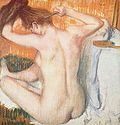Human back: Difference between revisions
CSV import |
CSV import |
||
| Line 29: | Line 29: | ||
{{stub}} | {{stub}} | ||
<gallery> | |||
File:Labled_diagram_of_the_muscles_of_the_human_back.svg|Labeled diagram of the muscles of the human back | |||
File:Edgar_Germain_Hilaire_Degas_029.jpg|Edgar Germain Hilaire Degas painting | |||
File:Scourged_back_by_McPherson_&_Oliver,_1863,_retouched.jpg|Scourged back by McPherson & Oliver, 1863 | |||
File:Thai_tattoo_Chiang_Mai_2005_058.jpg|Thai tattoo, Chiang Mai, 2005 | |||
</gallery> | |||
Latest revision as of 05:04, 18 February 2025
Human back refers to the large posterior area of the human body, rising from the top of the buttocks to the back of the neck and the shoulders. It is the surface of the body opposite from the chest. The vertebral column runs the length of the back and creates a central area of recession. The breadth of the back is created by the shoulders at the top and the pelvis at the bottom.
Anatomy[edit]
The back comprises the vertebral column, which houses the spinal cord, a part of the central nervous system. It also includes the ribs that extend from the spine. The back is supported by the muscular system which includes the latissimus dorsi, rhomboids, and trapezius muscles.
Vertebral column[edit]
The vertebral column is a column usually consisting of 24 articulating vertebrae, and 9 fused vertebrae in the sacrum and the coccyx. It is situated in the dorsal aspect of the torso, separated by intervertebral discs. It houses and protects the spinal cord in its spinal canal.
Muscular system[edit]
The muscular system of the back includes several layers of muscle. The superficial layer, the extrinsic muscles, move the shoulder blades and provide connections from the limbs to the trunk. They include trapezius, latissimus dorsi, levator scapulae, and rhomboids. The deep layer, the intrinsic muscles, support and rotate the spine.
Health and pathology[edit]
Back pain is a common problem, often caused by poor posture while sitting or standing, bending awkwardly, or lifting incorrectly. It's usually caused by minor damage to the ligaments and muscles in the back. The spinal cord is also susceptible to a number of pathologies, including spinal cord injury, spina bifida, scoliosis, and spinal disc herniation.






